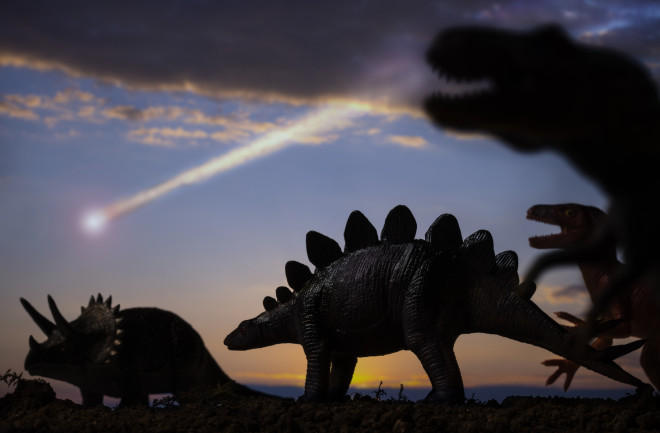When a 6-mile-wide asteroid struck Earth at the end of the Cretaceous period some 66 million years ago, it wiped out the majority of living organisms. Many victims were instantly fried by fires or drowned in tsunamis. The rest, meanwhile, succumbed to hostile conditions and the gradual collapse of entire ecosystems. In the end, about three-quarters of all species were swept into oblivion.
Yet many also survived and, eventually, repopulated the planet. Every living thing today is descended from the resourceful (or lucky) few who found ways to eke out an existence in that apocalyptic landscape. But how did those organisms persist long enough to see the world through to better days?
Which Animals Were Able to Survive the Asteroid Impact?
The challenge to life was immediate — within minutes of the impact, a global pulse of thermal radiation raised Earth’s surface to lethal temperatures. Marine species were safely insulated, but the survival of land-dwellers demands explanation.
In 2004, a University of Colorado Boulder researcher named Douglas Robertson and his colleagues introduced the sheltering hypothesis: The animals with the best shot at lasting through those initial hours were the ones who could escape to cooler environments. From crocodiles and lizards to birds and mammals, as Robertson put it in a later paper, “all the surviving species were plausibly able to take shelter from heat and fire underground or in water.”
In addition to the radiation, fossil evidence suggests the asteroid also flung tons of molten rock into the atmosphere. There, it hardened into deadly glass shards which then fell back to Earth, shredding any animals stranded in the open.
This first hurdle rewarded specific characteristics, namely small bodies and a burrowing or semi-aquatic lifestyle. Dinosaurs, for the most part, didn’t fit the bill, and many experts believe the vast majority died before the end of that cataclysmic day.
Read More: The End of the Dinosaurs: What Was the End-Cretaceous Mass Extinction?
What Challenges Did the Survivors Face?
As for the survivors, their trials were far from over, and shelter was no guarantee of long-term security. As soon as they emerged, they had to confront a land ravaged by wildfires — and soon to be shrouded by “impact winter” as a result of dust, soot and other atmospheric particles blocking the sun. The world’s forests had been reduced to ash, and they wouldn’t be growing back soon.
With photosynthesis on hiatus, animals that depended on living plant matter were in for a bad time. Without plants, the herbivores starved; without herbivores, the carnivores starved. Specialized diets were a great idea when the getting was good, but became a liability when primary producers — plants and other microorganisms, like algea and certain kinds of bacteria, that get their energy from sunlight — stopped producing.
That left the unfussy insectivores, scavengers and seed-eaters to pick up whatever scraps they could find and carry on as vegetation slowly returned. University of Wisconsin paleontologist Peter Sheehan writes in Geology that because their food chains were based on detritus rather than living biomass, “there was a food supply adequate for the interval when photosynthesis was halted.”
Read More: Flowering Plants Survived The Dinosaur-Killing Asteroid
What Came After the Dinosaurs?
The big post-extinction story is the sudden rise of mammals. When the asteroid struck, it deposited a thin layer or iridium around the globe: Below that layer, fossils show that dinosaurs were Earth’s undisputed rulers; above it they disappear, leaving a few unimposing, shrew-like creatures to take charge.
The traditional, simplified explanation is that dinosaurs held their would-be competitors at bay by filling all the major ecological niches. While the top dogs were still kicking, mammals were forced to remain diminutive and unspecialized .(Today, these critters are described by some scientists and journalists as rat-like creatures “scurrying in the shadows.”)
In reality, several mammalian lineages flourished throughout the dinosaur age, growing to medium size and acquiring all sorts of novel diets and behaviors. An extinct group of rodent-like animals called multituberculates was particularly prosperous, as were the forebears of modern marsupials.
Read More: Did a Dust Plume Kill the Dinosaurs?
What Were the Eutherians?
A group of organisms called eutherians (our direct ancestors) were indeed archetypal scurriers, subjugated by more dominant powers. But that turned out alright for them in the end — not only did they eventually get the chance to proliferate into the 6,000 diverse placental mammals we see today, but it’s likely they survived because of their abilities to live in the shadow of the dinosaurs.
As generalized creatures low on the totem pole, eutherians were primed for disaster. They hid until the coast was clear, then got by eating whatever they could. Even their slightness played to their advantage: Besides not needing many calories, small-bodied species typically have shorter gestation periods and reach sexual maturation faster, allowing them to quickly replenish their numbers.
In the aftermath, writes University of Edinburgh paleontologist Steve Brusatte, “these plucky survivors forged a new world.”
Read More: Mammals Diversified Much More Rapidly 66 Million Years Ago
Why Did Some Animals Survive While Others Were Wiped Out?
In the end, however, it’s hard to know why certain animals survived and others perished. Extinctions are often described, aptly, as the greatest mysteries of all time — it’s nearly impossible to determine what killed who, and why (not to mention why it didn’t kill everything else).
Even the best theories come with conundrums. Why did crocodiles fare better than mosasaurus, both being aquatic carnivores? Why didn’t a single one of the small, omnivorous non-avian dinosaurs make it out alive?
In many cases, survival may have been no more than a matter of chance. It’s possible some branches of the animal kingdom endured to the present simply because a pocket of their late-Cretaceous representatives, for whatever reason, lucked out with uniquely tolerable circumstances while the rest of the planet withered. For all we know, that’s the only reason we’re here today.

